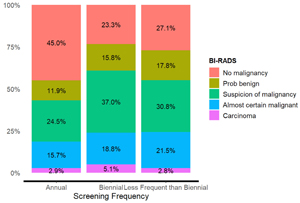A Retrospective Chart Analysis Comparing Breast Cancer Detection Rates Between Annual Versus Biennial Mammograms
DOI:
https://doi.org/10.14740/jocmr6081Keywords:
Breast cancer, Mammogram, Annual, Biennial, ACR, USPSTFAbstract
Background: Per American Cancer Society, breast cancer is one of the most prevalent causes of cancer-related mortality in women in the United States. Different organizations vary in their recommendations regarding frequency of mammograms, with the United State Preventive Service Taskforce recommending biennial screening and other organizations like American College of Radiology promoting annual screening. The purpose of this study was to analyze institutional data to compare breast cancer detection rates among women undergoing annual vs. biennial mammograms.
Methods: In this retrospective chart review, we analyzed deidentified records of women aged 25 to 74 at Northeast Georgia Health System, who had undergone at least two screening mammograms and were diagnosed with primary breast cancer. We analyzed several variables including Breast Imaging Reporting and Data System (BI-RADS) categorization, estrogen receptor (ER) status, progesterone receptor (PR) status, human epidermal growth factor receptor 2 (HER2) status, age, race, ethnicity, nodal involvement, smoking status, insurance status, grade, tumor size, number of screening mammograms, personal history of breast cancer, family history of breast cancer, and their correlation to screening frequency (annual vs. biennial vs. less than biennial).
Results: Among the total 2,219 records that satisfied the inclusion criteria, we observed that BI-RADS categorization (P < 0.001), ER status (P = 0.003), and PR status (P = 0.001) were associated with mammogram screening frequency while the other variables were not statistically significant. Post-hoc analysis revealed that biennially screened patients exhibited less N2 node involvement than expected (P = 0.022). Additionally, Hispanic/Latino(a) patients had a greater frequency of biennial screenings than expected (P = 0.050). Lastly, post-hoc analysis revealed that current smokers had a greater incidence of less-frequent-than-biennial screenings (P = 0.023).
Conclusions: Annual mammograms were associated with a lower BI-RADS stage and lower stage of breast cancer diagnosis.

Published
Issue
Section
License
Copyright (c) 2024 The authors

This work is licensed under a Creative Commons Attribution-NonCommercial 4.0 International License.









